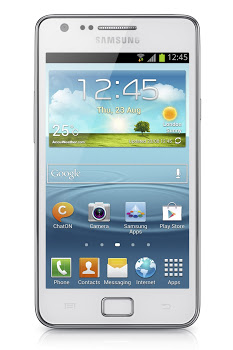The electronics behemoth that is Samsung sometimes works in mysterious ways — penning axiomatic smartphone slogans such as ‘designed for humans‘, for instance — but there’s very little mystery about the latest smartphone addition to its vast, sprawling Galaxy of devices. The Galaxy S II Plus is all about making the most of a winning formula by milking the 3G cash-cow of the range — aka the Galaxy S II.
The original Galaxy S II launched back in Q2 2011 — and was arguably the handset that gave birth to the Samsung we know (and love) today: the dominant force in phones (and the fifth tech horseman). It was also arguably the smartphone that turbo-charged the Android ecosystem — by pairing it with high-end hardware to die for, and a software topper that was slick enough to compete with iOS. The Galaxy S II sold and sold. In June 2012 Samsung announced channel sales had hit 28 million units — a figure it told TechCrunch is now “very much out of date”, so make your best guestimates for how many millions of S IIs are out there in the wild. (In the S II Plus’ release, Samsung dubs the S II “one of the world’s most recognized phones”.)
Whatever that figure clearly Samsung reckons, given the right software atop it, this 2011 handset can continue to sell — and so enter stage right: the S II Plus. (Update: According to new Samsung channel sales figures, the company has sold more than 40 million Galaxy SII units in 20 months on sale.)
The Galaxy S II Plus is the Galaxy S II — but running the Jellybean flavour of Android out of the box, rather than Gingerbread. Design and internal hardware appear all but identical, judging by the spec sheets, although there is an NFC version of the S II Plus which is a new addition. But looking at the basics, the two phones are clones (something Samsung has a habit of doing): dual-core 1.2Ghz handsets packing a 4.3 inch Super AMOLED Plus display. It’s the software that’s getting the big upgrade here — with Android 4.1.2, and Samsung software additions including Popup Video, S Voice, Voice Unlock, S Beam, Direct Call, Smart Stay, Smart Alert and AllShare Play.
Here’s Samsung describing the S II Plus’ software features:
The GALAXY S II Plus also sports a range of additional features that boost performance and the overall experience in entirely new ways. Popup Video allows a video to play anywhere on the screen in a resizable pop-up window while simultaneously running other tasks, eliminating the need to close and restart videos when checking new emails or surfing the Web. S Voice lets users control the phone using their voice; and Voice Unlock lets users unlock the phone using their own voice.
The staying power of the Galaxy S II can’t have passed Samsung by — not with S II owners vociferously hankering to get Android updates, and complaining loudly when a promised update to Android 4.0 took longer than they’d hoped. Since then an update to Android 4.1 has been rumoured to be on the cards — but hasn’t yet officially broken cover. The arrival of the Galaxy S II Plus suggests a rollout can’t be too far away though. Although asked when/if this was coming, a spokesman for Samsung told TechCrunch: “With the S II Plus being released with 4.1 we will investigate if the original version [ie the Galaxy S II] will also enjoy the upgrade.” Update: A second Samsung spokesman provided slightly more clarity by saying: “I can confirm that the Galaxy SII is in scope for an Android 4.1 JellyBean update, although I can’t give you an exact timing with regards to roll-out, as that may differ from country to country and carrier to carrier.”
Availability of the Galaxy S II Plus is unclear at this point, as Samsung could not confirm which global markets will be getting the handset — although it did say the U.K. won’t be getting the phone. So Brit S II owners will have to hope and pray for a Jellybean update. Update: Samsung says the Galaxy S II Plus will launch in Germany, before being rolled out to “other markets”.
In an age of continual updates, it’s interesting to see Samsung recycling and reusing 2011 hardware. But it just underlines how, in the mobile space, it’s the software that really counts. Also noteworthy: dual-core chips are still apparently powerful enough for that next-gen software.

